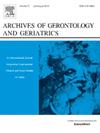Effects of the triglyceride-glucose index on non-alcoholic fatty liver disease: Causal evidence from longitudinal cohort studies
IF 3.8
3区 医学
Q2 GERIATRICS & GERONTOLOGY
引用次数: 0
Abstract
Background
Insulin resistance (IR) is strongly related to non-alcoholic fatty liver disease (NAFLD). Triglyceride-glucose (TyG) index serves as a novel substitute indicator for IR. However, research on the effect of TyG index on NAFLD remains sparse. This study aims to investigate the causal association between TyG index and incident NAFLD.
Methods
The primary cohort consisted of 27,052 participants from the Beijing Health Management Cohort, while the external validation cohort included 75,023 participants from the Taiwan MJ Cohort. Entropy balancing for continuous treatments (EBCT) combined with logistic regression and targeted maximum likelihood estimation (TMLE) were used to evaluate the causal association between the TyG index and incident NAFLD.
Results
During a median follow-up of 2.49 years in the primary cohort, 6,168 participants (median age: 36.0 years) developed incident NAFLD. EBCT combined with logistic regression revealed the odds ratio (95 % CI) of NAFLD risk was 1.742 (1.478–2.054) for each 1-unit increase in the baseline TyG index. In the TMLE model, the risk ratio (95 % CI) for NAFLD was 1.540 (1.406–1.687) in the Q4 (quartile 4) group compared with the Q1 group. These findings were consistent with those from the external validation cohort, reinforcing the robustness of the causal relationship between the TyG index and NAFLD incidence.
Conclusions
The advanced double-robust estimation method suggests that a higher baseline TyG index may be causally associated with an increased NAFLD risk, providing more reliable evidence for its role as a simple biomarker and demonstrating the utility of double-robust estimation causal inference models in epidemiology.
甘油三酯-葡萄糖指数对非酒精性脂肪性肝病的影响:来自纵向队列研究的因果证据
背景:胰岛素抵抗(IR)与非酒精性脂肪性肝病(NAFLD)密切相关。甘油三酯-葡萄糖(TyG)指数是一种新的IR替代指标。然而,关于TyG指数对NAFLD影响的研究仍然很少。本研究旨在探讨TyG指数与NAFLD发生的因果关系。方法主要队列包括来自北京健康管理队列的27,052名参与者,外部验证队列包括来自台湾MJ队列的75,023名参与者。采用连续治疗熵平衡(EBCT)结合logistic回归和目标最大似然估计(TMLE)来评估TyG指数与NAFLD事件之间的因果关系。在主要队列的中位随访2.49年期间,6168名参与者(中位年龄:36.0岁)发生了NAFLD事件。EBCT联合logistic回归显示,基线TyG指数每增加1个单位,NAFLD风险的比值比(95% CI)为1.742(1.478-2.054)。在TMLE模型中,与Q1组相比,Q4(四分位数4)组NAFLD的风险比(95% CI)为1.540(1.406-1.687)。这些发现与外部验证队列的结果一致,加强了TyG指数与NAFLD发病率之间因果关系的稳健性。结论先进的双稳健估计方法表明,较高的基线TyG指数可能与NAFLD风险增加有因果关系,为其作为简单生物标志物的作用提供了更可靠的证据,并证明了双稳健估计因果推理模型在流行病学中的实用性。
本文章由计算机程序翻译,如有差异,请以英文原文为准。
求助全文
约1分钟内获得全文
求助全文
来源期刊
CiteScore
7.30
自引率
5.00%
发文量
198
审稿时长
16 days
期刊介绍:
Archives of Gerontology and Geriatrics provides a medium for the publication of papers from the fields of experimental gerontology and clinical and social geriatrics. The principal aim of the journal is to facilitate the exchange of information between specialists in these three fields of gerontological research. Experimental papers dealing with the basic mechanisms of aging at molecular, cellular, tissue or organ levels will be published.
Clinical papers will be accepted if they provide sufficiently new information or are of fundamental importance for the knowledge of human aging. Purely descriptive clinical papers will be accepted only if the results permit further interpretation. Papers dealing with anti-aging pharmacological preparations in humans are welcome. Papers on the social aspects of geriatrics will be accepted if they are of general interest regarding the epidemiology of aging and the efficiency and working methods of the social organizations for the health care of the elderly.

 求助内容:
求助内容: 应助结果提醒方式:
应助结果提醒方式:


